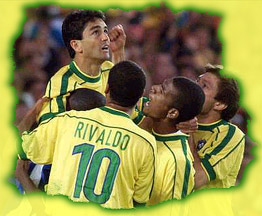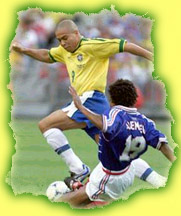
Watching World Cup
Soccer
in Latin America

"There is art, dignity, genius, luck and bad luck, Gods and demons, freedom and fate, flags, hymns and tears, and above all, the discovery that although Brazil is bad at lots of things, it is good with the ball. It is a football champion, which is very important. After all, it is better to be champion in samba, carnival and football than in wars and sales of rockets. If the serious commentators say we suffer from lack of education, inflation, and unequal distribution of wealth, football provides a contrast. It shows we can love Brazil with its hymn and its flag, maintaining our lucidity relative to the regime we want to transform." Roberto Da Matta., Carnivals, Rogues and Heroes: An interpretation of the Brazilian dilemma.
The World Cup is supposed to be the single sports tournament that is watched on television by the most number of people in the world. Of all events, the widely watched World Cup must be the most visible display for the countries who make it into the final tournament. This is the chance for an otherwise obscure nation to take center stage for billions of people around the world to see.
For advertisers, the huge television audience for the World Cup is a huge bonus. Unfortunately, perhaps, this event happens only once every four years, the most recent one being in the summer of 1998. According to the Los Medios y Mercados de Latinoamérica 1998 study, 54% of Latin Americans between the ages of 12 and 64 years old watched the 1998 World Cup soccer games regularly. This particular survey was conducted immediately after the 1998 World Cup, and it was felt that the survey could not be conducted while the tournament was going on since normal patterns of behavior would be disrupted.
According to the following table, the World Cup games viewers are more likely to be male, young and affluent.
| Demographic Characteristics | % watched World Cup soccer games regularly |
| Sex Male Female |
61% 46% |
| Age 12 - 17 18 - 24 25 - 34 35 - 44 45 - 54 55 - 64 |
54% 54% 55% 56% 52% 55% 48% |
| Years of education Less than 6 years Six years or more, but less than 12 years 12 years of more |
50% 56% 53% |
| Socio-economic
Level Level A (Top 10%) Level B (Next 20%) Level C (Next 30%) Level D (Bottom 40%) |
67% 62% 55% 46% |
| Major Urban Areas | 53% |
| Total | 54% |
(Source: Los Medios y Mercados de Latinoamérica 1998)

The following table shows the distribution of the World Cup audience by Latin American country. Although all countries of the world are eligible to participate in the World Cup tournament, most of them are eliminated in the earlier rounds. The spots in the finals are allocated according to pre-set quotas by geographical region, in order to maintain worldwide interest. In 1998, the Latin American representation in France consisted of Argentina, defending champion Brazil, Chile, Colombia, Mexico and Paraguay.
| Country | % watched World Cup soccer games regularly |
| Argentina Bolivia Brazil Chile Colombia Costa Rica Dominican Republic Ecuador El Salvador Guatemala Honduras Mexico Nicaragua Panama Paraguay Peru Uruguay Venezuela |
52% 10% 81% 40% 46% 61% 20% 56% 64% 61% 50% 31% 7% 47% 30% 22% 43% 40% |
| TOTAL | 54% |
(Source: Los Medios y Mercados de Latinoamérica 1998)
Here are some reflections:
Brazil went into the tournament as the defending champion from 1994, the number one ranked team in 1998 according to FIFA and therefore the favorite to repeat. Interest by Brazilians was obviously sky-high, especially given that this country is traditionally soccer-crazy. As Betty Milan said, "Football reflected the nationality, it mirrors the nation. Without football we Brazilians do not exist --- just as one could not conceive of Spain without the bullfight ..." Since Brazil made it all the way to the final before losing to the host country France, we are not surprised to find that Brazil has the largest television audience level among Latin Americans for the World Cup games.
Although Argentina and Colombia qualified to go to France, their performances were not ideal. Argentine soccer seemed to be haunted by the shadow of Diego Maradonna, not present at this World Cup, and his supposed heir Ariel Lopez was disappointing. Colombia was racked by team dissension, with star striker Faustino Asprillo sent home for disputing with the coach.
It is somewhat surprising to see the relatively low audience levels for Mexico and Paraguay. Both teams made it to France, and put in courageous and impressive efforts in the second round against Holland and France before bowing out, with a couple of genuine mediagenic stars (goal scorer Luis ("El Matador") Hernandez from Mexico and goalkeeper José Luis Chilavert from Paraguay).
Although some of the smaller countries were not represented in France, their people followed these games closely because this is a chance to watch world-class soccer. These include Costa Rica, Ecuador, Guatemala and Honduras.
In spite of the stereotypical image of all Latin Americans as being soccer-crazy, this is not true. In some countries, baseball is in fact more popular. Thus, we see that Nicaraguans and Dominicans are much less involved in World Cup mania.
But we should perhaps not forget what Mason wrote: "Great victories are momentary distractions but the harsh realities of poverty and unemployment, class and race quickly return."

2002 World Cup qualifying match: Argentina vs. Brazil
![]()
WORLD WIDE WEB LINKS
SPORTS CABLE CHANNELS
BOOK REFERENCES
(posted by Roland Soong on 5/31/00)
(Return to Zona Latina's Home Page)